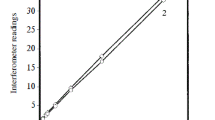Abstract
Adsorption of the cationic polymers poly(methacrylamidopropyltrimethyl ammonium chloride) (PMAPTAC) and poly(1,1-dimethylpiperidinium-3,5-diallylmethylene chloride) (PDMPDAMC) on human hair was studied by measurements of the amount of polymer adsorbed and by the streaming potential method. Results reflect the amphoteric nature of the keratin surface and show that the excess of anionic sites at pH values above 4 is the main driving force for the adsorption of cationic polyelectrolytes. Lowering the pH below 4 or addition of neutral salt (KCl) reduces the amount of adsorbed polymer. It was shown that the adsorption of cationic polymer in the concentration range 0.01 to 0.1 % and at neutral pH reverses the overall character of the surface from anionic to cationic. Keratin fibers modified in this manner do not exhibit amphoteric character and bear excess positive charge in the pH range 2–9.5. The value of the amount of the polymer adsorbed at saturation concentration (∼2 mg/g) as well as the lack of molecular weight effect in the range (5 · 104 − 106) on the amount of polymer adsorbed suggest that polymer chains adopt a rather extended conformation on the fiber surface. Some data concerning the formation of a complex between adsorbed cationic polymer and anionic detergents or polyelectrolytes are also presented.
Similar content being viewed by others
References
Goddard ED, Faucher JA, Scott RJ, Turney ME (1975) J Soc Cosmet Chem 26:539
Faucher JA, Goddard ED, Hannan RB (1977) Text Res J 47)9):616
Onabe F (1979) J Appl Polym Sci 22:3495; (1979) ibid 23:2909; (1979) ibid 23:2999; (1979) ibid 24:1629
Somasundaran P, Kulkarni RD (1973) J Coll Interf Sci 45(3):591
Nardin U, Papirer E, Schultz J (1982) J Coll Interf Sci 88:204
Ball B, Furstenau DW (1973) Miner Sci Eng 5:267
Cook HD, Smith IT (1971) Appl Polym Symp 18:663
Parreira HC (1980) J Coll Interf Sci 75:212
Davies JT, Rideal EK (1961) Interfacial Phenomena, Academic Press, New York — London, p 114
Robertson AA, Mason SG (1949) Pulp Paper Mag Can 50(13):103
Morris C, Dubin P, Garcia, unpublished data
Onabe F (1982) Mokusai Gakkaishi 28:445
Horn D, Heuck C (1983) J Biol Chem 258:1665
Dubin P, Levy I (1982) J Chromatogr 235:377
Wolfram L (1981) (eds) Orfanos, Montagna, Stuttgen, Hair Research, Springer Verlag, Berlin — Heidelberg, pp 479–500
Steinhard J, Reynolds JA (1969) Multiple Equilibria in Proteins, Academic Press, New York-London, p 178
Healy TW, White LR (1978) Adv Coll Interf Sci 9:303
For a given species, molar extent of reaction is defined ase=(ni-ni o)/Vi whereni o is the initial number of moles of speciesi, ni is the number of moles of speciesi after conversion andv i is stoichiometic coefficient
Shaw DJ (1980) Introduciton to Colloid and Surface Chemistry, Butterworths, London — Boston, p 153
Faucher JA, Goddard ED (1976) J Coll Interf Sci 55(2):313
Hesselink FTh (1977) J Coll Interf Sci 60(3):448
Fantana BJ (1971) (ed) Hair ML, The Chemistry of Biosurfaces, Vol I, Marcel Dekker, New York
Dawkins JV, Guest MJ, Taylor G (1982) (ed) Tadros ThF, The Effect of Polymers on Dispersion Properties, Academic Press, London — New York, p 45
Belton D, Stupp SI (1983) Macromol 16(7):1143
For polymer-polymer complexes: Michaels AS, Uiv L, Schneider NS (1965) J Phys Chem 69:1447; Cundall RB, LawtonJB, Murray D (1979) Makromol Chem 180:2913; Tsuchida E, Osada Y, Sanada K (1972) J Polym Sci 10:3397
For polymer-detergent complexes: Goddard ED, Hanna RB (1976) J Coll Interf Sci 55:73; Hayakawa K, Santerre JP, Kwak JCT (1983) Makromol 16:1642 and the references cited therein; Dubin P, Oteri R (1983) J Coll Interf Sci 95(2):453
Wolfram LJ, Cohen D, Tehrani N (1983) US Patent 4 416 297, to Clairol Inc
March J (1977) Advanced Organic Chemistry, McGraw-Hill, New York, p 227
Jachowicz J, Wis-Surel G, Garcia M (1985) J Soc Cosmet Chem 36:189
Author information
Authors and Affiliations
Rights and permissions
About this article
Cite this article
Jachowicz, J., Berthiaume, M. & Garcia, M. The effect of the amphiprotic nature of human hair keratin on the adsorption of high charge density cationic polyelectrolytes. Colloid & Polymer Sci 263, 847–858 (1985). https://doi.org/10.1007/BF01412964
Received:
Accepted:
Issue Date:
DOI: https://doi.org/10.1007/BF01412964




